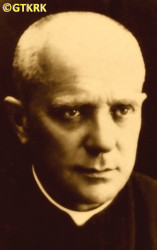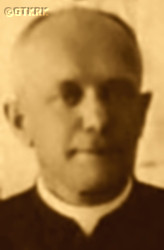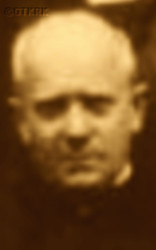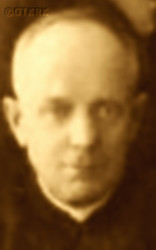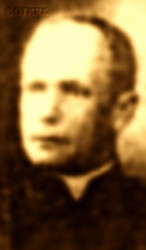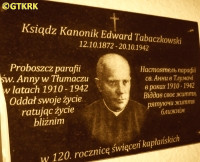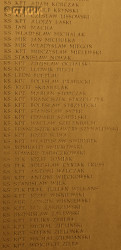Roman Catholic
St Sigismund parish
05-507 Słomczyn
85 Wiślana Str.
Konstancin deanery
Warsaw archdiocese, Poland
full list:
displayClick to display full list

searchClick to search full list by categories
wyświetlKliknij by wyświetlić pełną listę po polsku

szukajKliknij by przeszukać listę wg kategorii po polsku

Martyrology of the clergy — Poland
XX century (1914 – 1989)
personal data
surname
TABACZKOWSKI
surname
versions/aliases
TABACZARZ
forename(s)
Edward
function
diocesan priest
creed
Latin (Roman Catholic) Church RCmore on
en.wikipedia.org
[access: 2014.09.21]
diocese / province
Lviv archdiocesemore on
en.wikipedia.org
[access: 2013.05.19]
honorary titles
Expositorii Canonicalis canonmore on
Expositorii Canonicalis canon
(1909)
„Medal of Independence”more on
„Medal of Independence”
(16.03.1937)
„Cross of Civil Merit” i.e. Germ. Zivil‐Verdienstkreuz (Austro–Hungarian Empire) — Golden with the Crownmore on
„Cross of Civil Merit” i.e. Germ. Zivil—Verdienstkreuz (Austro-Hungarian Empire) – Golden with the Crown
(c. 1909)
date and place
of death
20.10.1942

Stanislavivtoday: Ivano‐Frankivsk, Stanislaviv/Ivano‐Frankivsk rai., Stanislaviv/Ivano‐Frankivsk obl., Ukraine
more on
en.wikipedia.org
[access: 2020.11.20]
alt. dates and places
of death
06.1941
details of death
At the beginning of World War I 1914‐1918 — the Austro–Hungarian Empire declared war on Imperial Russia on 05.08.1914 — a supporter and initiator of Polish youth from the Tlumach area joining the Polish Legions, being formed at the Army of the Austro–Hungarian Monarchy, under the command of Joseph Piłsudski. In Eastern Galicia — i.e. the eastern part of the Austro–Hungarian province and the crown land of the Germ. Königreich Galizien und Lodomerien (Eng. Kingdom of Galicia and Lodomeria), the Eastern Legion was being formed in Lviv, but due to the rapid retreat of the Austro–Hungarian army under the pressure of the Russians, it did not reach the planned strength and was disbanded. In his Tlumach, c. 20 km from Stanislaviv, there prob. was a squad of the Riflemen's Association (there was one in Stanislaviv), of which prob. was a chaplain. And these units were transformed in 08.1914 into legion units. However, they did not have time to formally become units of the Polish Legions, because already on 03.09.1914 the Russians entered Tlumach and Stanislaviv. The local legionnaires probably withdrew to the west with the Austro–Hungarian troops.
After German and Russian invasion of Poland in 09.1939 and start of the World War II, during Russian occupation (1939‐1941) helped Poles deported by Russians to Siberia.
Sent them parcels, organized help to the families left behind.
Sold out his own house to help the most needy.
Collaborated with the emerging Polish resistance movement, prob. Armed Struggle Union ZWZ (part of the Polish Clandestine State).
During German occupation (after German attack on 22.06.1941 on their erstwhile ally, the Russians) betrayed by a Jewish woman, „scared and bitten by dogs set on her”, and denounced by Ukrainian nationalists for hiding Jewish students in rector's office, issuing false birth certificates for them and organizing food aid for Jews confined in the ghetto, arrested on c. 01.10.1942 by the Ukrainian Germ. Ukrainische Hilfspolizei (Eng. Ukrainian Auxiliary Police). Before the war, in 1939, 2,350 Jews (40% of the total population) lived in Tlumach. In 1941 there were about 2,800 of them. From 22.06.1941 to 09.1941, Tlumach was occupied by the Hungarians, who ordered the Jews to wear armbands with the Star of David, but prevented pogroms by the Ukrainians. After the German occupation began, the Germans on 05‐06.04.1942 resettled c. 1,000 Jews to Stanislaviv, but soon brought others from the Tlumach area, so that their number in the city swelled to c. 3,500. At the same time, in 04‐05.1942, a ghetto was established (initially open) and executions began in the Jewish cemetery (the largest one on 04.06.1942 — Germans, with the cooperation of the Germ. Ukrainische Hilfspolizei, murdered 497 Jews, 15 Poles and 4 Ukrainians). Prob. on 08.09.1942, some, and on 27.11.1942 the rest (i.e. c. 2,000) — i.e. right at the time, when was arrested — Jews were transported to the German VL Belzec extermination, where all were murdered.
Handed over to Germans.
Tortured.
Perished in prison, imprisoned in a cell without a pallet, on bare concrete.
alt. details of death
According to other sources arrested in 1941 by the Russians.
Murdered by them in Stanislaviv prison, prob. during genocidal prison massacres after German attack of their erstwhile ally, Russians, in 06.1941.
cause of death
extermination
perpetrators
Germans
sites and events
StanislavivClick to display the description, Help to the JewsClick to display the description, GeneralgouvernementClick to display the description, 06.1941 massacres (NKVD)Click to display the description, Ribbentrop‐MolotovClick to display the description, Pius XI's encyclicalsClick to display the description
date and place
of birth
12.10.1872

Terebovlyatoday: Terebovlya urban hrom., Ternopil rai., Ternopil obl., Ukraine
more on
en.wikipedia.org
[access: 2020.11.20]
presbyter (holy orders)
ordination
03.07.1898

Lvivtoday: Lviv urban hrom., Lviv rai., Lviv obl., Ukraine
more on
en.wikipedia.org
[access: 2022.01.16]
positions held
1910 – 1942
parish priest — Tlumachtoday: Tlumach urban hrom., Stanislaviv/Ivano‐Frankivsk rai., Stanislaviv/Ivano‐Frankivsk obl., Ukraine
more on
en.wikipedia.org
[access: 2020.12.03] ⋄ St Anne RC parish ⋄ Stanislavivtoday: Ivano‐Frankivsk, Stanislaviv/Ivano‐Frankivsk rai., Stanislaviv/Ivano‐Frankivsk obl., Ukraine
more on
en.wikipedia.org
[access: 2020.11.20] RC deanery — also: founder of the Society for Christian Science in Tlumach (1924), responsible for supervision of the Private Female Teachers' Seminary he founded, run by the School Sisters de Notre Dame SSND, of which he was prefect (c. 1928‐1938); initiator of the establishment of the Cooperative Bank of the Catholic Self–Help Association and the county printing house; publisher of the magazine „Tlumach Intercessor” (1929‐1931)
1902 – 1910
parish priest — Kukezivtoday: Novyi Yarychiv hrom., Lviv rai., Lviv obl., Ukraine
more on
uk.wikipedia.org
[access: 2023.03.02] ⋄ St James the Apostle RC parish ⋄ Zhovkvatoday: Zhovkva urban hrom., Lviv rai., Lviv obl., Ukraine
more on
en.wikipedia.org
[access: 2020.11.22] RC deanery
1902
vicar — Holohorytoday: Zolochiv urban hrom., Zolochiv rai., Lviv obl., Ukraine
more on
en.wikipedia.org
[access: 2020.12.03] ⋄ Nativity of the Blessed Virgin Mary RC parish ⋄ Zolochivtoday: Zolochiv urban hrom., Zolochiv rai., Lviv obl., Ukraine
more on
en.wikipedia.org
[access: 2021.12.19] RC deanery
1900 – 1902
vicar — Skalattoday: Skalat urban hrom., Ternopil rai., Ternopil obl., Ukraine
more on
en.wikipedia.org
[access: 2020.11.15] ⋄ Assumption of the Blessed Virgin Mary RC parish ⋄ Skalattoday: Skalat urban hrom., Ternopil rai., Ternopil obl., Ukraine
more on
en.wikipedia.org
[access: 2020.11.15] RC deanery
1898 – 1900
vicar — Mykulyntsitoday: Mykulyntsi hrom., Ternopil rai., Ternopil obl., Ukraine
more on
en.wikipedia.org
[access: 2020.12.03] ⋄ Holy Trinity RC parish ⋄ Terebovlyatoday: Terebovlya urban hrom., Ternopil rai., Ternopil obl., Ukraine
more on
en.wikipedia.org
[access: 2020.11.20] RC deanery
1894 – 1898
student — Lvivtoday: Lviv urban hrom., Lviv rai., Lviv obl., Ukraine
more on
en.wikipedia.org
[access: 2022.01.16] ⋄ philosophy and theology, Metropolitan Theological Seminary
others related
in death
DZIURDZIAClick to display biography (Sr Sabine), KRATOCHWILClick to display biography Mary Anne (Sr Mary Antonina), ŁAPAClick to display biography (Sr Jeronima)
sites and events
descriptions
Stanislaviv: Prison used by the Russians (in 1939‐1941 — in 06.1941, when escaping from advancing Germans, Russians perpetrated a mass murder on prison inmates — and from 1944); the Germans (in 1941‐1944); and again by the Russian occupiers after replacing Germans in 1944. Thousands of Poles were jailed there. (more on: stanislawow.netClick to attempt to display webpage
[access: 2014.01.06], stanislawow.netClick to attempt to display webpage
[access: 2014.01.06])
Help to the Jews: During World War II on the Polish occupied territories Germans forbid to give any support to the Jews under penalty of death. Hundreds of Polish priests and religious helped the Jews despite this official sanction. Many of them were caught and murdered.
Generalgouvernement: After the Polish defeat in the 09.1939 campaign, which was the result of the Ribbentrop‐Molotov Pact and constituted the first stage of World War II, and the beginning of German occupation in part of Poland (in the other, eastern part of Poland, the Russian occupation began), the Germans divided the occupied Polish territory into five main regions. In two of them new German provinces were created, two other were incorporated into other provinces. However, the fifth part was treated separately, and in a political sense it was supposed to recreate the German idea from 1915 (during World War I, after the defeat of the Russians in the Battle of Gorlice in 05.1915) of creating a Polish enclave within Germany. Illegal in the sense of international law, i.e. Hague Convention, and public law, managed by the Germans according to separate laws — especially established for the Polish Germ. Untermenschen (Eng. subhumans) — till the Russian offensive in 1945 it constituted part of the Germ. Großdeutschland (Eng. Greater Germany). Till 31.07.1940 formally called Germ. Generalgouvernement für die besetzten polnischen Gebiete (Eng. General Government for the occupied Polish lands) — later simply Germ. Generalgouvernement (Eng. General Governorate), as in the years 1915‐1918. From 07.1941, i.e. after the German attack on 22.06.1941 against the erstwhile ally, the Russians, it also included the Galicia district, i.e. the Polish pre‐war south‐eastern voivodeships. A special criminal law was enacted and applied to Poles and Jews, allowing for the arbitrary administration of the death penalty regardless of the age of the „perpetrator”, and sanctioning the use of collective responsibility. After the end of the military conflict of the World War UU, the government of the Germ. Generalgouvernement was recognized as a criminal organization, and its leader, governor Hans Frank, guilty of war crimes and crimes against humanity and executed. (more on: en.wikipedia.orgClick to attempt to display webpage
[access: 2024.12.13])
06.1941 massacres (NKVD): After German attack of Russian‐occupied Polish territory and following that of Russia itself, before a panic escape, Russians murdered — in accordance with the genocidal order issued on 24.06.1941 by the Russian interior minister Lawrence Beria to murder all prisoners (formally „sentenced” for „counter‐revolutionary activities”, „anti‐Russian acts”, sabotage and diversion, and political prisoners „in custody”), held in NKVD‐run prisons in Russian occupied Poland, Lithuania, Latvia and Estonia — c. 40,000‐50,000 prisoners. In addition Russians murdered many thousands of victims arrested after German attack regarding them as „enemies of people” — those victims were not even entered into prisons’ registers. Most of them were murdered in massacres in the prisons themselves, the others during so‐called „death marches” when the prisoners were driven out east. After Russians departure and start of German occupation a number of spontaneous pogroms of Jews took place. Many Jews collaborated with Russians and were regarded as co‐responsible for prison massacres. (more on: en.wikipedia.orgClick to attempt to display webpage
[access: 2021.12.19])
Ribbentrop‐Molotov: Genocidal Russian‐German alliance pact between Russian leader Joseph Stalin and German leader Adolf Hitler signed on 23.08.1939 in Moscow by respective foreign ministers, Mr. Vyacheslav Molotov for Russia and Joachim von Ribbentrop for Germany. The pact sanctioned and was the direct cause of joint Russian and German invasion of Poland and the outbreak of the World War II in 09.1939. In a political sense, the pact was an attempt to restore the status quo ante before 1914, with one exception, namely the „commercial” exchange of the so‐called „Kingdom of Poland”, which in 1914 was part of the Russian Empire, fore Eastern Galicia (today's western Ukraine), in 1914 belonging to the Austro‐Hungarian Empire. Galicia, including Lviv, was to be taken over by the Russians, the „Kingdom of Poland” — under the name of the General Governorate — Germany. The resultant „war was one of the greatest calamities and dramas of humanity in history, for two atheistic and anti‐Christian ideologies — national and international socialism — rejected God and His fifth Decalogue commandment: Thou shall not kill!” (Abp Stanislav Gądecki, 01.09.2019). The decisions taken — backed up by the betrayal of the formal allies of Poland, France and Germany, which on 12.09.1939, at a joint conference in Abbeville, decided not to provide aid to attacked Poland and not to take military action against Germany (a clear breach of treaty obligations with Poland) — were on 28.09.1939 slightly altered and made more precise when a treaty on „German‐Russian boundaries and friendship” was agreed by the same murderous signatories. One of its findings was establishment of spheres of influence in Central and Eastern Europe and in consequence IV partition of Poland. In one of its secret annexes agreed, that: „the Signatories will not tolerate on its respective territories any Polish propaganda that affects the territory of the other Side. On their respective territories they will suppress all such propaganda and inform each other of the measures taken to accomplish it”. The agreements resulted in a series of meeting between two genocidal organization representing both sides — German Gestapo and Russian NKVD when coordination of efforts to exterminate Polish intelligentsia and Polish leading classes (in Germany called «Intelligenzaktion», in Russia took the form of Katyń massacres) where discussed. Resulted in deaths of hundreds of thousands of Polish intelligentsia, including thousands of priests presented here, and tens of millions of ordinary people,. The results of this Russian‐German pact lasted till 1989 and are still in evidence even today. (more on: en.wikipedia.orgClick to attempt to display webpage
[access: 2015.09.30])
Pius XI's encyclicals: Facing the creation of two totalitarian systems in Europe, which seemed to compete with each other, though there were more similarities than contradictions between them, Pope Pius XI issued in 03.1937 (within 5 days) two encyclicals. In the „Mit brennender Sorge” (Eng. „With Burning Concern”) published on 14.03.1938, condemned the national socialism prevailing in Germany. The Pope wrote: „Whoever, following the old Germanic‐pre‐Christian beliefs, puts various impersonal fate in the place of a personal God, denies the wisdom of God and Providence […], whoever exalts earthly values: race or nation, or state, or state system, representatives of state power or other fundamental values of human society, […] and makes them the highest standard of all values, including religious ones, and idolizes them, this one […] is far from true faith in God and from a worldview corresponding to such faith”. On 19.03.1937, published „Divini Redemptoris” (Eng. „Divine Redeemer”), in which criticized Russian communism, dialectical materialism and the class struggle theory. The Pope wrote: „Communism deprives man of freedom, and therefore the spiritual basis of all life norms. It deprives the human person of all his dignity and any moral support with which he could resist the onslaught of blind passions […] This is the new gospel that Bolshevik and godless communism preaches as a message of salvation and redemption of humanity”… Pius XI demanded that the established human law be subjected to the natural law of God , recommended the implementation of the ideal of a Christian state and society, and called on Catholics to resist. Two years later, National Socialist Germany and Communist Russia came together and started World War II. (more on: www.vatican.vaClick to attempt to display webpage
[access: 2023.05.28], www.vatican.vaClick to attempt to display webpage
[access: 2023.05.28])
sources
personal:
www.glaukopis.plClick to attempt to display webpage
[access: 2012.11.23], nawolyniu.plClick to attempt to display webpage
[access: 2013.01.06], cracovia-leopolis.plClick to attempt to display webpage
[access: 2013.01.06], biographies.library.nd.eduClick to attempt to display webpage
[access: 2014.05.09]
bibliographical:
„Register of Latin rite Lviv metropolis clergy’s losses in 1939‐45”, Józef Krętosz, Maria Pawłowiczowa, editors, Opole, 2005
„Biographical lexicon of Lviv Roman Catholic Metropoly clergy victims of the II World War 1939‐1945”, Mary Pawłowiczowa (ed.), Fr Joseph Krętosz (ed.), Holy Cross Publishing, Opole, 2007
„Schematismus Universi Saecularis et Regularis Cleri Archi Diaeceseos Metropol. Leopol. Rit. Lat.”, Lviv Metropolitan Curia, from 1860 till 1938
„Mysterium iniquitatis. Clergy and religious of the Latin rite murdered by Ukrainian nationalists in 1939‐1945”, Fr Józef Marecki, Institute of National Remembrance IPN, Kraków 2020
original images:
www.facebook.comClick to attempt to display webpage
[access: 2019.10.13], www.google.plClick to attempt to display webpage
[access: 2017.03.11], www.google.plClick to attempt to display webpage
[access: 2017.03.11], www.google.plClick to attempt to display webpage
[access: 2017.03.11], www.kchodorowski.republika.plClick to attempt to display webpage
[access: 2013.01.26], docplayer.plClick to attempt to display webpage
[access: 2019.10.13], ipn.gov.plClick to attempt to display webpage
[access: 2019.02.02]
LETTER to CUSTODIAN/ADMINISTRATOR
If you have an Email client on your communicator/computer — such as Mozilla Thunderbird, Windows Mail or Microsoft Outlook, described at WikipediaPatrz:
en.wikipedia.org, among others — try the link below, please:
LETTER to CUSTODIAN/ADMINISTRATORClick and try to call your own Email client
If however you do not run such a client or the above link is not active please send an email to the Custodian/Administrator using your account — in your customary email/correspondence engine — at the following address:

giving the following as the subject:
MARTYROLOGY: TABACZKOWSKI Edward
To return to the biography press below:
 Click to return to biography
Click to return to biography








